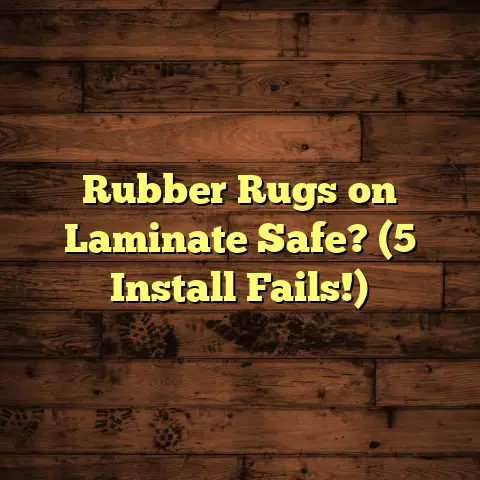Water Based Wood Stain? (4 VOC Facts You Need!)
I’ve been slinging stain and sealing wood for over 20 years.
If there’s one thing I’ve seen change in this industry, it’s the growing demand for eco-friendly products.
More and more, homeowners like you are looking for ways to improve their homes without harming the planet (or their lungs!).
That’s where water-based wood stains come in.
They’re becoming super popular, and for good reason.
They offer a fantastic alternative to traditional oil-based stains, boasting lower toxicity, fewer volatile organic compounds (VOCs), and a much easier cleanup.
Let’s dive into why you should seriously consider making the switch.
Section 1: Understanding VOCs (Volatile Organic Compounds)
So, what exactly are these VOCs everyone’s so worried about?
VOC stands for Volatile Organic Compound.
These are chemicals that evaporate at room temperature.
You’ll find them in a ton of household products, from cleaning supplies to… you guessed it… paints and stains.
Think of that “new paint smell.” That’s VOCs off-gassing.
Now, while that smell might seem harmless, VOCs can actually be pretty nasty.
Here’s the deal: VOCs can cause a range of health problems, especially with prolonged exposure.
We’re talking respiratory issues, headaches, dizziness, and even long-term effects on your nervous system.
No fun, right?
And it’s not just about your personal health.
VOCs contribute to outdoor air pollution, leading to smog and other environmental problems.
According to the EPA, VOCs, along with nitrogen oxides (NOx), react in the atmosphere to form ozone, a major component of smog.
Section 2: The Benefits of Water-Based Wood Stains
Okay, so VOCs are bad.
But how do water-based stains stack up against the traditional oil-based stuff?
Let’s break it down:
- Lower VOC Content: This is the big one.
Water-based stains generally have significantly fewer VOCs than oil-based stains.
We’re talking a difference you can actually feel while working. - Quick Drying Times: Nobody wants to wait forever for their stain to dry.
Water-based stains dry much faster, often in just a couple of hours, compared to the 24 hours or more for oil-based. - Easy Application: Water-based stains tend to be thinner and easier to apply evenly.
They also raise the wood grain less than oil-based stains, leading to a smoother final finish. - Low Odor: Remember that “new paint smell”?
Water-based stains have a much milder odor, making them ideal for indoor projects. - Vibrant Colors: Water-based stains can often achieve brighter and more vibrant colors than oil-based stains, while still maintaining that eco-friendly profile.
- Easy Clean-up: This is a game-changer.
Cleaning up water-based stain is as simple as soap and water.
No harsh solvents needed!
Section 3: VOC Facts You Need to Know
Alright, let’s get down to the nitty-gritty with some crucial VOC facts.
I’m going to share some insider knowledge that will help you make informed decisions when choosing your next wood stain.
VOC Fact #1: 50-70% Fewer VOCs: Water-based stains typically contain 50% to 70% fewer VOCs than their oil-based counterparts.
That’s a huge difference!
For example, a typical oil-based stain might contain 350-450 grams of VOCs per liter (g/L), while a water-based stain might have only 100-200 g/L.VOC Fact #2: Virtually VOC-Free Options Exist: Some water-based stains are formulated to be virtually VOC-free.
These are a fantastic option if you’re particularly sensitive to chemicals or have health concerns.
Look for stains labeled “zero-VOC” or “low-VOC.”
These stains often use innovative technologies to achieve excellent performance without relying on harmful solvents.VOC Fact #3: Exceeding Regulatory Standards: Many water-based stains exceed regulatory standards for VOC emissions.
This means they’re not just meeting the requirements, they’re going above and beyond to protect your health and the environment.
The EPA sets limits for VOC content in architectural coatings.
Water-based stains frequently come in well below these limits, making them a safer choice for indoor use.VOC Fact #4: Long-Term Impact on Indoor Air Quality: Using low-VOC products like water-based stains has a significant long-term impact on your indoor air quality.
By reducing the amount of VOCs released into your home, you’re creating a healthier living environment for yourself and your family.
This is especially important for people with allergies, asthma, or other respiratory conditions.
Section 4: Application and Maintenance of Water-Based Wood Stains
Okay, you’re sold on water-based stains.
Now, how do you actually use them?
Don’t worry, I’ve got you covered.
Here’s a step-by-step guide to achieving a beautiful finish with water-based wood stain:
Step 1: Preparation is Key
- Sanding: Start by sanding your wood surface smooth.
The grit you use will depend on the wood and the desired finish, but generally, start with 120-grit and work your way up to 220-grit. - Cleaning: After sanding, remove all dust with a tack cloth or vacuum.
Even a tiny bit of dust can ruin your finish. - Pre-Conditioning (Optional): Some woods, like pine, can be blotchy when stained.
Applying a wood conditioner before staining can help ensure an even color.
Step 2: Application Time
- Stir, Don’t Shake: Stir the stain thoroughly to ensure the pigment is evenly distributed.
Shaking can create bubbles that will affect the finish. - Apply Evenly: Use a high-quality brush, foam applicator, or rag to apply the stain in the direction of the wood grain.
- Wipe Off Excess: After a few minutes (check the manufacturer’s instructions for the recommended time), wipe off any excess stain with a clean cloth.
This is crucial for achieving an even color. - Multiple Coats (Optional): If you want a darker color, apply a second or even third coat of stain, allowing each coat to dry completely before applying the next.
Step 3: Sealing the Deal
- Apply a Topcoat: Once the stain is completely dry, apply a clear topcoat to protect the finish and enhance its durability.
Water-based polyurethanes are a great option for water-based stains. - Light Sanding Between Coats: Lightly sand between coats of topcoat with fine-grit sandpaper (320-grit or higher) to create a smooth, even finish.
Maintenance Tips:
- Regular Cleaning: Clean stained wood surfaces regularly with a damp cloth and mild soap.
- Avoid Harsh Chemicals: Avoid using harsh chemicals or abrasive cleaners, as they can damage the finish.
- Touch-Ups: If the finish becomes scratched or worn, you can apply a fresh coat of topcoat to restore its luster.
Section 5: Popular Brands and Products
Okay, so you’re ready to buy some water-based stain.
But with so many options out there, how do you choose the right one?
Here are a few leading brands that I recommend, known for their commitment to sustainability and low-VOC formulations:
- General Finishes: General Finishes is a well-respected brand known for its high-quality water-based stains and topcoats.
Their products are durable, easy to apply, and offer a wide range of colors. - Minwax: Minwax is a household name in wood finishing, and they offer a variety of water-based stains that are readily available at most home improvement stores.
- Varathane: Varathane is another popular brand that offers a good selection of water-based stains and sealers.
Choosing the Right Product:
- Indoor vs.
Outdoor: Make sure to choose a stain that is specifically formulated for either indoor or outdoor use.
Outdoor stains will have added UV protection to prevent fading. - Wood Type: Some stains work better on certain types of wood.
For example, gel stains are often recommended for woods with tight grain. - Desired Color: Consider the color you want to achieve and choose a stain that matches your vision.
It’s always a good idea to test the stain on a scrap piece of wood before applying it to your project.
Section 6: Real-Life Applications and Case Studies
Let’s get real for a second.
I want to share some stories of homeowners who have successfully used water-based wood stains in their projects.
The Kitchen Cabinet Makeover: One of my clients, Sarah, was looking to update her kitchen cabinets without breaking the bank.
We used a water-based stain to give her old oak cabinets a fresh, modern look.
The low odor was a huge plus, and she was thrilled with the results.The Refinished Coffee Table: Another client, John, had an old coffee table that was looking worn and tired.
We sanded it down and applied a water-based stain in a rich, dark color.
The coffee table now looks like a brand-new piece of furniture, and John couldn’t be happier.The Eco-Friendly Flooring Project: I recently worked on a flooring project where the homeowner was adamant about using eco-friendly products.
We used a water-based stain and sealer, and the results were stunning.
The floor looks beautiful, and the homeowner can rest easy knowing that they made a sustainable choice.
Conclusion
I hope this article has given you a better understanding of water-based wood stains and their benefits.
As a flooring contractor with years of experience, I can tell you that these products are a game-changer.
They offer a safer, more sustainable way to achieve beautiful results in your home.
By choosing eco-friendly products like water-based wood stains, you’re not just protecting your health and the environment, you’re also investing in the future.
So, the next time you’re planning a home improvement project, consider making the switch to water-based stain.
You won’t regret it!





